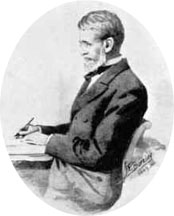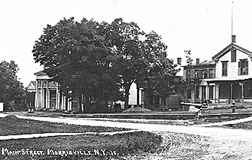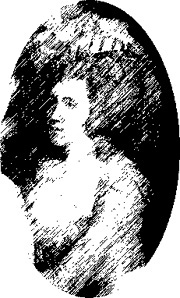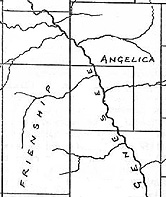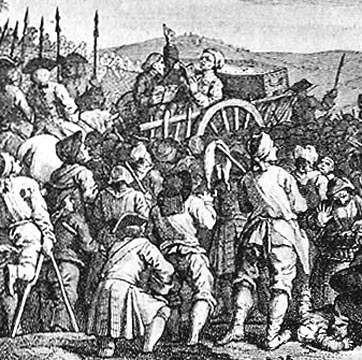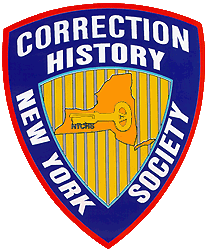 | on Executions by Hanging in New York State (Page 10: 1820 - 1824) |
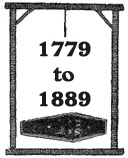
|
With links to more information on selected cases.
Open | Close
|
Can you fill any data gaps? Please e-mail webmaster Thomas C. McCarthy at NYCHS@nyc.rr.com | |
| 1820 |
According to Judge Nathaniel Bartlett Sylvester's 1878 History of Saratoga County, New York, transcribed by Bill Carr on the Saratoga County GenWeb Site, the victim was an elderly man named Seth Hawkins, known for being too fond of the drink. He had asked for and was given some buttermilk at Bennett's homestead in Cornith while Benjamin was not there. But when Bennet saw Hawkins leaving, the farmer grabbed a whip from a passing wagon and beat the old man so mercilessly that passersby stepped in and took the whip away. Some hours later, when Hawkins was noticed missing, searchers found him dying, not far from Bennett's place, a stone covered with blood and hair nearby. Bennett was hung in Ballston after being tried and convicted.
| ||||||
1823 |
Exactly nine years to the month after his daughter's execution in Peterboro, the old warrior -- he had fought on the American side during the Revolution -- was hanged in Morrisville.
Ezra Cloyes, as sheriff, presided over the hanging that took place in an open field west of the Morrisville cemetery. Erected in an hollow, the gallows could be viewed by a entire throng of perhaps 2,000. According to Chapter 49 (Town of Eaton) of the 1880 James H. Smith History of Chenango and Madison Co., New York,, transcribed by Douglas Clark and posted on the Madison County NYGenWeb Project site maintained by Tim Stowell, it was last public execution of a criminal in Madison County. Reportedly some authorities worried about a possible "insurrection of Indians."
Sheriff Cloyes is described as performing his executioner duties with some regret out of affection for the old man who, despite his criminal deed, was seen as possessing many noble traits of character. When an opportunity arose to escape Cloyes's jail, Antoine deliberately refused to flee.
For the father-and-daughter story of murders and executions, see the Sept. 30, 1814 entry on Page 7 of this NYCHS Timeline on Executions by Hanging in New York State.
|
||||||
1824 |
Nothing much on the web details the crime, trial or execution of How other than indicating that Church had been fatally shot and that How's trial took place in 1824 on Feb. 4th and 5th in a room over the first Angelica jail that stood on the site later to become the setting for a Catholic Church.
Angelica, the oldest town in the county, received its name from founder Captain Philip Church in honor of his mother Angelica Schuyler Church. The Church family's land agent and surveyor Evert Van Wickle built the community's first framed house in 1802. The structure marked its 200th anniversary in 2002.
Angelica Schuyler Church's father was General Philip John Schuyler, a member of the Continental Congress and an early U.S. senator from New York. Angelica's mother was Catharine van Rensselaer of Albany. Angelica's sister Elizabeth was married to Alexander Hamilton. Husband John Church had served as General Washington's Commissary General during the war. Mrs. Church maintained a life-long friendship with Thomas Jefferson and his daughter.
Aside from a well-known last name, the murder victim had credentials in his own right. According to John S. Minard's 1896 Allegany County and its People: A Centennial History of Allegany County, New York (708-712), as posted by Vivian Karen Bush on the Allegany County, New York GenWeb site, Othello Church took just about the first major step toward establishment of the hamlet that became Friendship, a town neighboring Angelica on the southeast.
That happened in 1815 when he erected a gristmill on the a creek bank near what became the foot of Water street. Not long afterward he built a home on where later the American House stood.
According to Friendship Chronicle editor Richmond C. Hill's Random Ramblings, again as posted by Vivian Karen Bush on the Allegany County, New York GenWeb site, Othello Church and other community leaders met Oct. 17, 1821, in the local schoolhouse to form Friendship's First Baptist Society and to plan the eventually establishment of its church. Othello and two others were elected trustees.
A previously out-of-print book entitled The Life and Confessions of David D. How, Who Was Executed at Angelica, Allegany County, New York, on Friday, March 19, 1824, for the Murder of Othello Church, written by an itinerant preacher Elder Joseph Badger, details the case.
In an e-mail received by NYCHS, former Angelica Town Historian Robert Dorsey of 3466 Center Dr., Wellsville, NY 14895, reports that he has had reprinted Elder Badger's The Life and Confession of David D. How. Dorsey reports including in the book accounts of all 4 Angelica hangings between 1824 and 1882. Contact Dorsey concerning the book entitled Executions In Allegany County, New York (63 pages, $11 including shipping).
On April 2, 1824, a white 45-year-old boarding house landlord John Johnson was hanged for the robbery-murder of a sailor who had rented a room from him. According to excerpts from Andrew Roth's Infamous Manhattan posted on the Fighting 9th (Precinct) Club site that features many pages devoted to East Village crime fighting history: Johnson, either alone or with a boarder named Jerry, crushed sailor James Murray's head with the blunt side of a hatchet. Jerry escaped upstate. Johnson dragged the body into Cuyler's Alley, a small street where now stands the NYSE Stock Clearing Building downtown. The body was traced back to Johnson, who confessed within days. The public execution in an open field at what is now 2nd Ave. and 13th St. in Manhattan's East Village drew a massive turnout of spectators estimated upwards to 50,000. That, if true, would have been about a third of the city's population. Charles H. Haswell, whose Reminiscences of New York by an Octogenarian (1816 - 1860) appear in an NYCHS excerpts presentation elsewhere on this web site, provides a detailed description of the event:
On June 11, 1824, a black seaman named Thomas Jones was hanged for murder.* |
|
Back to Page 1: 1779 - 1784
Back to Page 2: 1785 - 1791 Back to Page 3: 1792 - 1794 Back to Page 4: 1795 - 1801 |
Back to Page 5: 1802 - 1806
Back to Page 6: 1807 - 1812 Back to Page 7: 1813 - 1815 Back to Page 8: 1816 - 1817 |
More 'Timeline on NYS Executions' under construction.
To |
To Executions |
